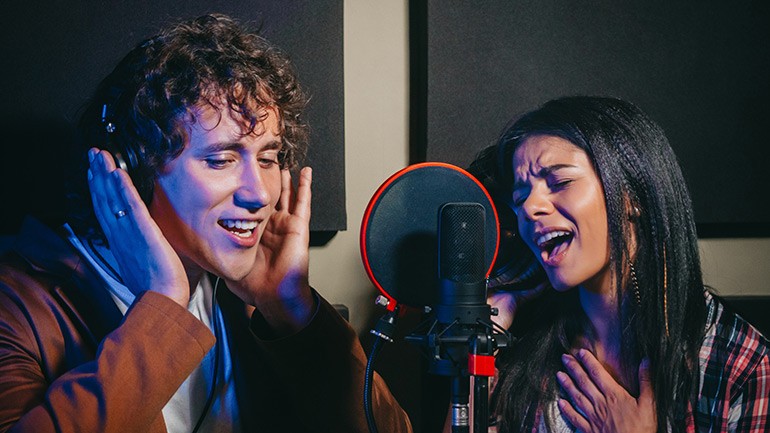Demoing for Duets
Some tips and tools for recording duos

While overdubbing has its merits, there’s something about capturing a pair of vocalists performing live in the studio, particularly when the song is specifically written as a duet. Naturally this situation presents a number of challenges, including whether to use one or two microphones, which type of mic is most effective, as well as getting a proper balance, adjusting equalization as needed, and more.
Choose your mic. Generally speaking, you’ll get the best results when using a large-diaphragm condenser microphone, which not only has a much wider pickup range than a run-of-the-mill dynamic mic but also offers significantly more gain. For this reason, a condenser is arguably your only choice when attempting to record multiple vocalists using a single mic (more on that in a bit). Additionally, most condensers allow you to choose from multiple pickup patterns, including cardioid (one side live), figure-of-eight (both sides live) and omni (live all around), and offer EQ and volume control as well.
Just one mic? While some may consider this a matter of taste, there are many pros who believe that the best way to cut a duet is to record the singers live in front of a single condenser microphone set to cardioid. In this way you’re capturing an actual “performance,” which often has an immediacy that’s missing when tracking the parts separately. As you might expect, this approach requires a bit of dexterity (not to mention singers who know how to self-blend). Allow 2-3’ between vocalists and microphone, and, if need be, slightly reposition the pair in order to achieve a good live balance. If you get it right, you’ll have your vocal blend already printed onto a single track with no further mixing necessary. (If the singers would like to make eye contact, as an alternative you could consider placing them on each side of the mic and switch the pickup pattern to figure of eight or omni.)
Or two? For all its merits, the one-mic method offers very little room for error—if one person messes up during the take, both will need to start again, either from the top or as a punch-in. For the more risk-averse, then, there’s nothing wrong with using a dedicated mic (and recording track) per singer, which comes with its own set of benefits. No mic-sharing means you could conceivably go with something basic like a set of Shure SM57s or similar dynamic mic; additionally, recording each vocal to a separate track eliminates the need for self-blending, and also allows you greater leeway when it comes to mixing as well as soloing, fine-tuning and/or repairing one part or the other.
Thickening tricks. Once you’ve got your vocal parts down, there are a few tricks you can try to add a bit more heft. Double-tracking is typically a good place to start, especially over select portions of, say, the verse melody, or maybe during the choruses. Rather than re-record the parts, you could cherry pick from some earlier takes, setting the “doubled” levels at around one-half to three-quarters of the main vocal volume. You can also experiment with panning the added vocals, or adding a modest amount of reverb or delay to the tracks.






Community
Connect with BMI & Professional Songwriters